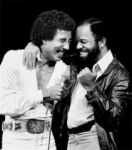DETROIT (AP)—On Jan. 12, 1959, Elvis Presley was in the Army. The Beatles were a little-known group called The Quarrymen casting about for gigs in Liverpool. The nascent rock ‘n’ roll world was a few weeks away from “the day the music died”—when a single-engine plane crash claimed the lives of Buddy Holly, J.P. “The Big Bopper” Richardson and Ritchie Valens.
 |
|
Smokey Robinson is joined by Berry Gordy
|
It’s also the day a 29-year-old boxer, assembly line worker and songwriter named Berry Gordy Jr. used an $800 family loan to start a record company in Detroit.
Fifty years later, Motown Records Corp. and its stable of largely African-American artists have become synonymous with the musical, social and cultural fabric of America. The company spawned household names, signature grooves and anthems for the boulevard and bedroom alike that transcended geography and race.
And time.
Motown may be 50 years old, but it isn’t any less relevant with current hitmakers—from Taylor Swift to Coldplay—citing the label’s signature “sound” as an influence.
Would there be a Beyonce or Mariah Carey had Diana Ross, Martha Reeves and Gladys Knight not come first?
How about Kanye West and Justin Timberlake? What would have become of their musical careers had Motown not blazed a trail with the likes of Michael Jackson, Smokey Robinson, Marvin Gaye, Stevie Wonder, The Temptations and The Four Tops?
“There were just so many amazing artists that came through. It was such a surge,” said singer-songwriter Jewel, whose recently released collection of original lullabies includes Motown influences. “And it really informed The Beatles’ melodies. So much of what pop music and popular culture became. I recommend everybody go back and look at those melodies and see where they find them today, because they’re resurfacing and being remixed, basically, into new pop songs.”
From its founding in 1959 to a much-debated move to Los Angeles 13 years later, what has become known as “classic Motown” created a once-in-a-lifetime sound that was local and global, Black and White, gritty and gorgeous, commercial and creative, Saturday night and Sunday morning.
“I Heard it Through the Grapevine.” “My Girl.” “The Tears of a Clown.”
Like the two-sided singles the Motown factory churned out 24 hours a day, seven days a week at Studio A inside the Hitsville, U.S.A., building at 2648 West Grand Blvd., Motown Records in the 1960s stood out from the musical pack—and still does today—because of its ability to tune the tension between two opposing forces.
Getting started:
“The thing that struck me was how ferociously determined he had to be to borrow that 800 bucks and start with nothing.”—Bill Clinton, former U.S. president
The tale of the $800 loan has become the stuff of legend.
Gordy worked at a Ford Motor Co. plant and wrote songs when he could, all the while dreaming of owning and running his own record company.
The loan from his family’s savings club allowed him to make that happen.
He had the vision and the seed money, but next Gordy needed the talent—the singers, songwriters and musicians.
He didn’t have far to look.
Detroit alone produced many of the creative wizards who gave Motown its initial burst.
Robinson and the Miracles attended high school together, while Ross and future Supremes Mary Wilson and Florence Ballard grew up in the city’s housing projects.
Gordy plucked from Detroit’s flourishing nightclub scene a group of supremely talented jazz musicians who would become the label’s house band, the Funk Brothers. Strings, winds and brass came from the Detroit Symphony Orchestra and other classical outlets.
And the prolific songwriting trio known as Holland-Dozier-Holland—Lamont Dozier and the Holland brothers, Brian and Eddie—also were local hires.
The talent was there.
(Mike Householder and Jeff Karoub are Associated Press Writers.)